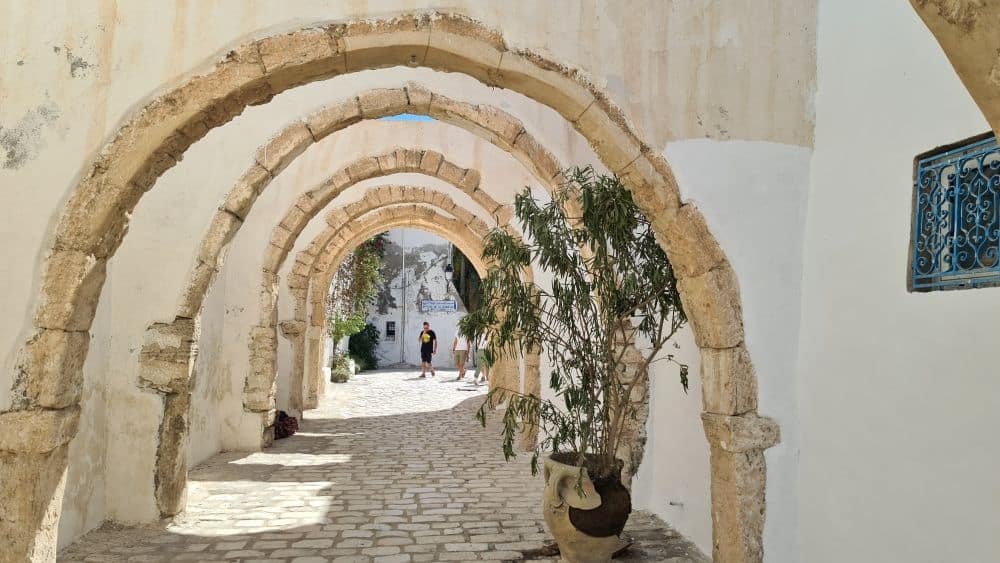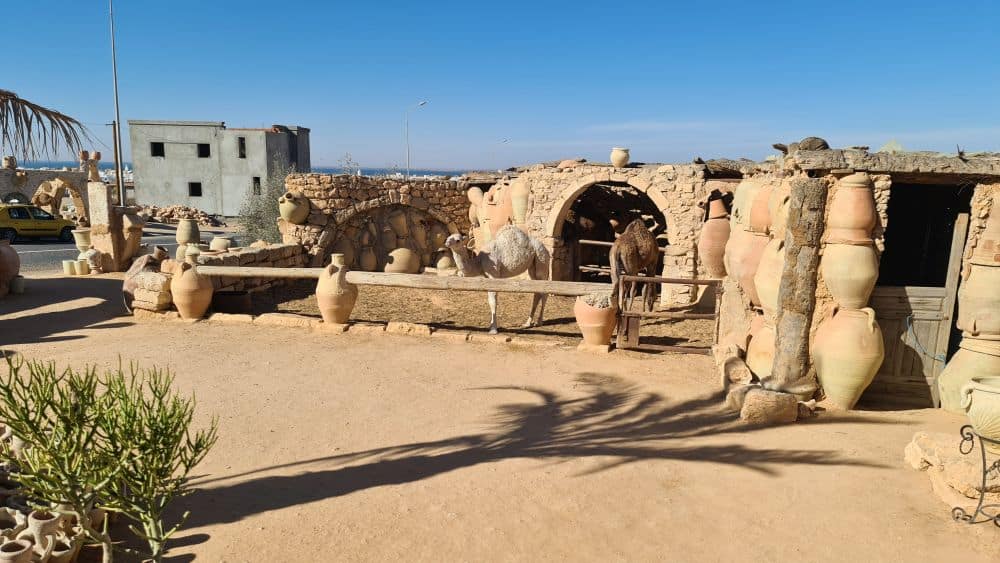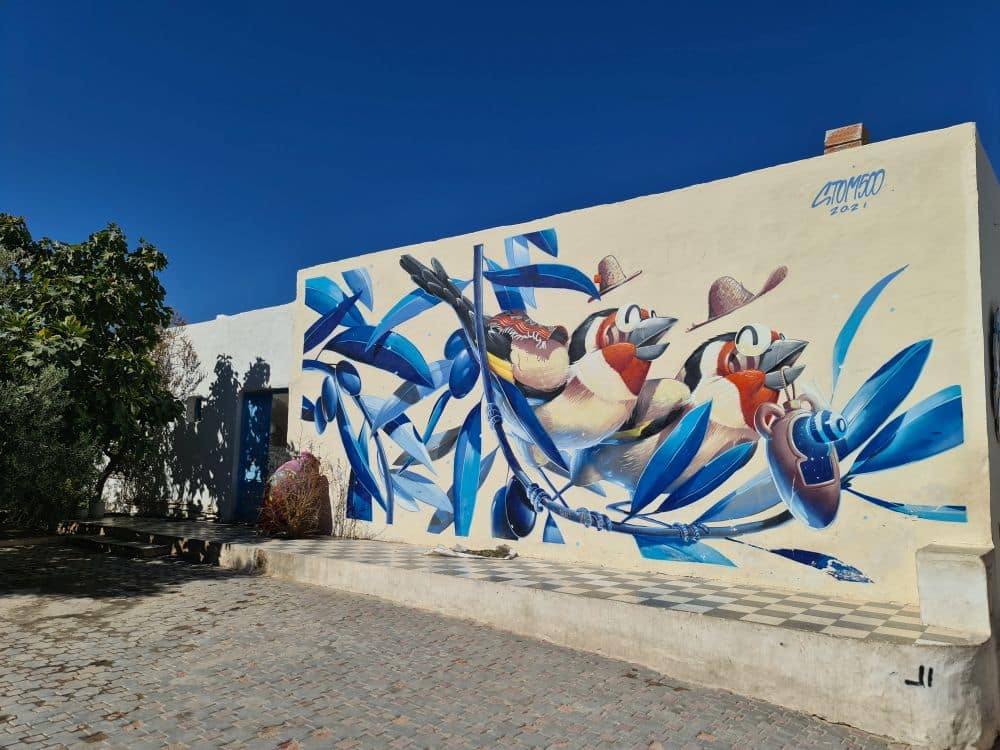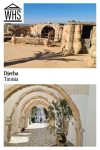Djerba: Testimony to a settlement pattern in an island territory
By Maria Dol
What is Djerba?
Djerba is an island in southeastern Tunisia that feels like another world – a mix of desert, sea, culture and history. It is the largest island in North Africa and the only place where I have seen Berber, Arab, Jewish and French traditions so organically intertwined. During my stay, I discovered not only beautiful beaches, but also mazes of white houses, ancient synagogues and colourful street art projects.

Disclosure: This article contains affiliate links. Making a purchase through an affiliate link will mean a small commission for this website. This will not affect your price. Privacy policy.
The island is compact but full of contrasts: the lively markets of Houmt Souk, the tranquillity of Guelala, the magic of El Ghrib. Everywhere I went, I felt a serenity that is hard to find on the mainland.
Why is Djerba a UNESCO World Heritage site?
Djerba was inscribed on the UNESCO World Heritage List in 2023 for its unique example of sustainable settlement and multicultural coexistence.
On the island, you’ll see preserved menzels – traditional farmhouses that are a key element of Djerba’s unique architecture. Groups of menzels formed rural communities, which were served by mosques and more urban-style market areas, linked by a road network. There are also underground mosques and religious monuments that have coexisted for centuries. This system, according to UNESCO, “reflected a symbiotic relationship between communities of diverse cultures and faiths who coexisted peacefully in Djerba and adapted their way of life to the conditions and restrictions of their water-scarce natural environment.”

What can you expect on a visit to Djerba?
My first impression was how different the atmosphere was from the rest of Tunisia. In Houmt Souk, the capital, I got lost in the narrow streets lined with shops selling everything from spices to traditional leather goods.
I walked to the El Ghrib synagogue – the oldest functioning synagogue in Africa. The sense of spirituality there was palpable. The wooden ceiling, blue-stained tiles and ancient scrolls give the place an almost mystical aura.
I was most impressed by the Djerbahood neighbourhood, where international street artists have turned the walls of houses into living art canvases. Each wall tells its own story, and the vibrant colours contrast with the white buildings.
I also visited Guelala, a village famous for its ceramics. I went to a workshop where a master showed me how to make clay pots using ancient techniques.
Take this cultural tour, which includes a pottery workshop.

The beaches are quiet, with fine white sand and crystal-clear water. Around the beaches of Midoun and Sidi Mahrez, I found ideal conditions for relaxing after the tours.
Try this 3-hour walking tour of Houmt Souk.
This private half-day tour includes visiting Houmt Souk, the synagogue, Djerbahood and the Guelala Museum.
There are also plenty of other activities to choose from: camel-riding, horse-riding, quad biking, jet skiing and dolphin-watching, for example.
Is the island worth visiting?
Yes, and more! Djerba is a destination that offers much more than a beach holiday: history, culture, crafts, authentic villages and beautiful nature in a compact area. It’s one of the most amazing places in Tunisia.
I recommend at least 3-4 days to really feel the spirit of the island and not just tick off the “beach stop”.
Look for accommodations in Djerba by clicking on the map below:
What sorts of travelers would like Djerba?
Lovers of history and religious architecture would enjoy seeing the island’s religious buildings, as would anyone who likes to explore off the beaten track. Families looking for a safe and peaceful holiday would find it here and so would any adventurers who value authenticity. And, of course, photographers and street-art lovers would find plenty to see and do.
Tips for visiting Djerba
The best times to visit the island are spring and autumn (April-June or September-October) when temperatures are pleasant and there are no large crowds.
Hire a car to get around the island in comfort.
Wear modest clothing in the villages, especially when visiting religious sites, to show respect for the local culture. Wear comfortable shoes for walking on the sandy and pebbled roads.
Bargain for better prices in Houmt Souk.
Tunisia’s other UNESCO sites are in the north of the country, but if you arrive or leave through Tunis, at least visit the Medina of Tunis and the Archaeological Site of Carthage.

Where is Djerba?
From the Tunisian mainland, take the so-called Roman road from Zarzis or a ferry from the village of Jorf. The journey from Zarzis to Djerba takes about 30 minutes.
Djerba has an international airport (DJE) on the north side of the island with direct flights from Tunis, France, Germany and other European countries. You can pick up a rental car right at the airport. The drive to the capital, Houmt Souk, takes about 20 minutes from the airport.
There are regular bus services from major cities such as Tunis and Sfax. The journey is long (8-10 hours).
For more information about Djerba, visit the Discover Tunisia website.
Have you been to Djerba? If so, do you have any additional information or advice about this UNESCO World Heritage site? Please add your comments below!

